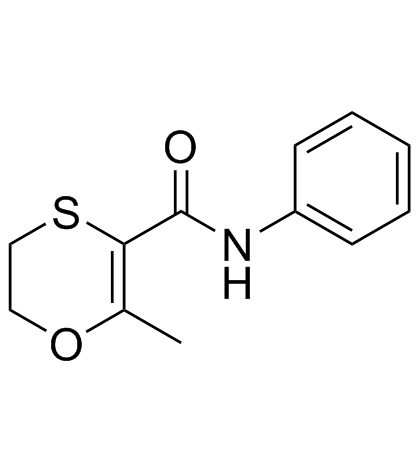萎锈灵

萎锈灵结构式

|
常用名 | 萎锈灵 | 英文名 | Carboxin |
|---|---|---|---|---|
| CAS号 | 5234-68-4 | 分子量 | 235.302 | |
| 密度 | 1.3±0.1 g/cm3 | 沸点 | 420.6±45.0 °C at 760 mmHg | |
| 分子式 | C12H13NO2S | 熔点 | 91.1-91.7°C | |
| MSDS | 中文版 美版 | 闪点 | 208.2±28.7 °C | |
| 符号 |

GHS07 |
信号词 | Warning |
|
The Adh1 gene of the fungus Metarhizium anisopliae is expressed during insect colonization and required for full virulence.
Microbiol. Res. 172 , 57-67, (2015) Zymography of alcohol dehydrogenase (ADH) activity in the entomopathogenic fungus Metarhizium anisopliae grown under various conditions revealed that micro-aerobic growth was associated with increased ADH activity. The major ADH protein, AdhIp, was purified t... |
|
|
Controlling food-contaminating fungi by targeting their antioxidative stress-response system with natural phenolic compounds.
Appl. Microbiol. Biotechnol. 70(6) , 735-9, (2006) The antioxidative stress-response system is essential to fungi for tolerating exposure to phenolic compounds. We show how this system can be targeted to improve fungal control by using compounds that inhibit the fungal mitochondrial respiratory chain. Targeti... |
|
|
Phototransformation of carboxin in water. Toxicity of the pesticide and its sulfoxide to aquatic organisms.
J. Agric. Food Chem. 52(20) , 6228-32, (2004) Sunlight exposure of aqueous suspensions of carboxin (1) causes its phototransformation to sulfoxide 2 and minor components. Similar effects are observed in the presence of humic acid or nitrate or at different pH values. Photoproducts 2-9 were isolated by ch... |
|
|
Flutolanil and carboxin resistance in Coprinus cinereus conferred by a mutation in the cytochrome b560 subunit of succinate dehydrogenase complex (Complex II).
Mol. Genet. Genomics 272(3) , 328-35, (2004) A gene that confers resistance to the systemic fungicide flutolanil was isolated from a mutant strain of the basidiomycete Coprinus cinereus. The flutolanil resistance gene was mapped to a chromosome of approximately 3.2 Mb, and a chromosome-specific cosmid l... |
|
|
Stimulation by surangin B of endogenous amino acid release from synaptosomes.
Toxicon 42(4) , 351-7, (2003) The effect of surangin B, an insecticidal natural product coumarin, on presynaptic release of endogenous amino acids was investigated using a purified synaptosomal fraction isolated from mouse brain. Surangin B stimulated the release of glutamic acid (GLU), g... |
|
|
Photochemical behaviour of the systemic fungicide carboxin.
Environ. Sci. Pollut. Res. Int. 9(2) , 107-9, (2002) Irradiation of carboxin (1) with a 500 W UV lamp (filter Pyrex) in CH3CN leads to the products 3, 5-8, 12-14 depending upon the reaction conditions. All photo-products were isolated and characterized. Photooxidation occurred even if unsensitized, while photoa... |
|
|
Five carboxin-resistant mutants exhibited various responses to carboxin and related fungicides.
Biosci. Biotechnol. Biochem. 75(1) , 181-4, (2011) Five carboxin-resistant mutants from Aspergillus oryzae were characterized by the sensitivities of their mycelial growth and succinate dehydrogenase (SDH) activity to carboxin and three related fungicides. Despite a significant resistance to carboxin, exhibit... |
|
|
Investigating dominant selection markers for Coprinopsis cinerea: a carboxin resistance system and re-evaluation of hygromycin and phleomycin resistance vectors.
Curr. Genet. 55(5) , 543-50, (2009) Dominant selectable markers are beneficial for transformation of many fungi, particularly those model species where repeated transformations may be required. A carboxin resistance allele of the Coprinopsis cinerea sdi1 gene, encoding the iron-sulphur protein ... |
|
|
The dominant Hc.Sdh (R) carboxin-resistance gene of the ectomycorrhizal fungus Hebeloma cylindrosporum as a selectable marker for transformation.
Curr. Genet. 55(2) , 223-31, (2009) In an attempt to get a marker gene suitable for genetical transformation of the ectomycorrhizal fungus Hebeloma cylindrosporum, the gene Hc.Sdh (R) that confers carboxin-resistance was isolated from a UV mutant of this fungus. It encodes a mutant allele of th... |
|
|
Effect of fungicide seed treatments on N2-fixation and nodulation in pea, Pisum sativum L.
Bull. Environ. Contam. Toxicol. 77(6) , 896-904, (2006)
|